University Report: Problems Associated with Breastfeeding in Maldives
VerifiedAdded on 2020/04/21
|17
|3894
|125
Report
AI Summary
This report addresses the challenges of breastfeeding in the Maldives. It begins by highlighting the importance of breastfeeding for infant health and development, then notes that while the Maldives has a high initial breastfeeding rate, the rate of exclusive breastfeeding drops significantly after six months. The report identifies key issues such as the impact of C-sections, family influence, misconceptions about milk supply, and the challenges faced by working mothers. It reviews literature on the topic, outlining the aims and objectives of a promotional campaign to increase awareness of exclusive breastfeeding. The report then details the plan of action, compares the planned timeline with the actual implementation, and discusses the successes achieved, including completing the assignment on time. Finally, it analyzes the barriers encountered, such as delays in topic finalization, and concludes with recommendations to improve breastfeeding practices in the Maldives. The report also includes a Gantt chart illustrating the revised timeline for the project.
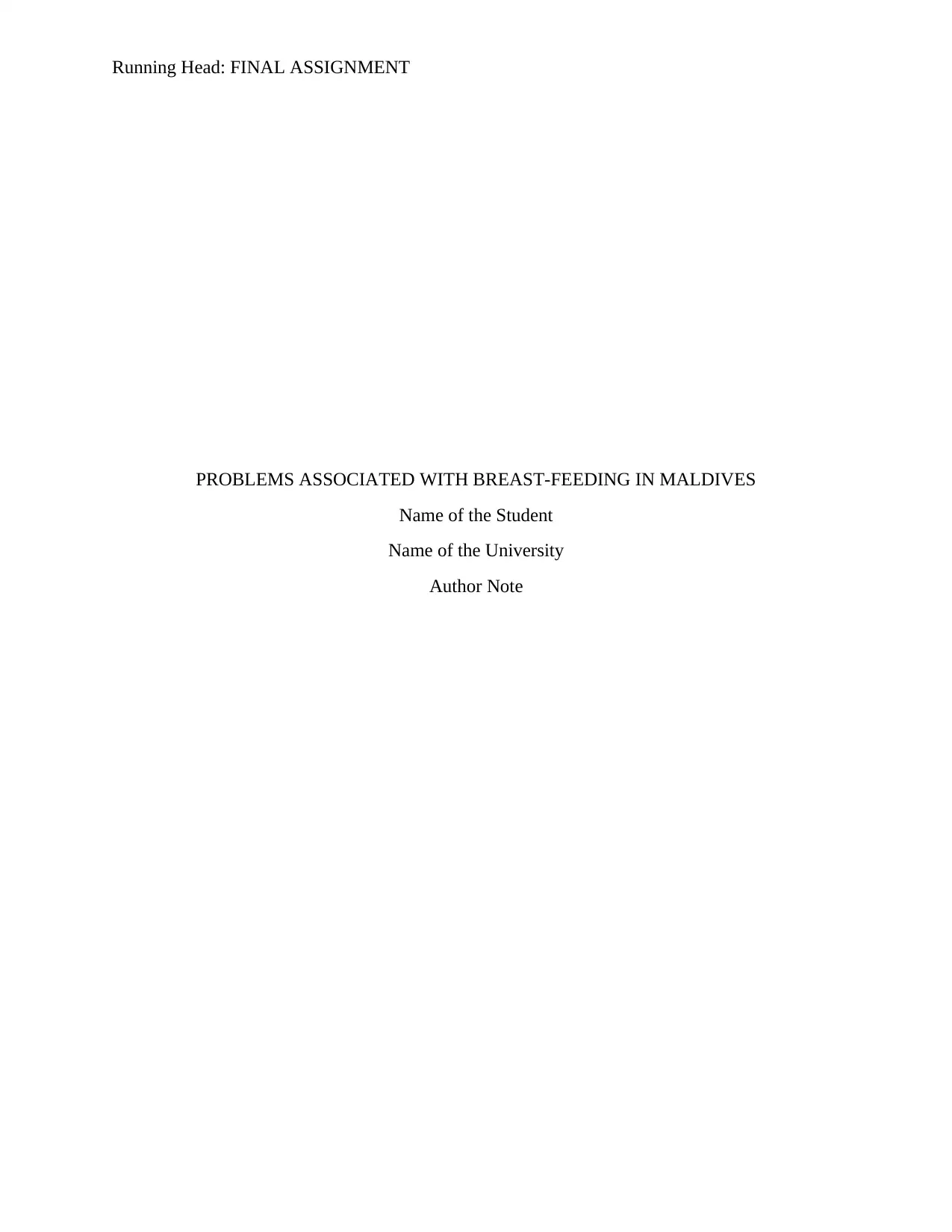
Running Head: FINAL ASSIGNMENT
PROBLEMS ASSOCIATED WITH BREAST-FEEDING IN MALDIVES
Name of the Student
Name of the University
Author Note
PROBLEMS ASSOCIATED WITH BREAST-FEEDING IN MALDIVES
Name of the Student
Name of the University
Author Note
Paraphrase This Document
Need a fresh take? Get an instant paraphrase of this document with our AI Paraphraser
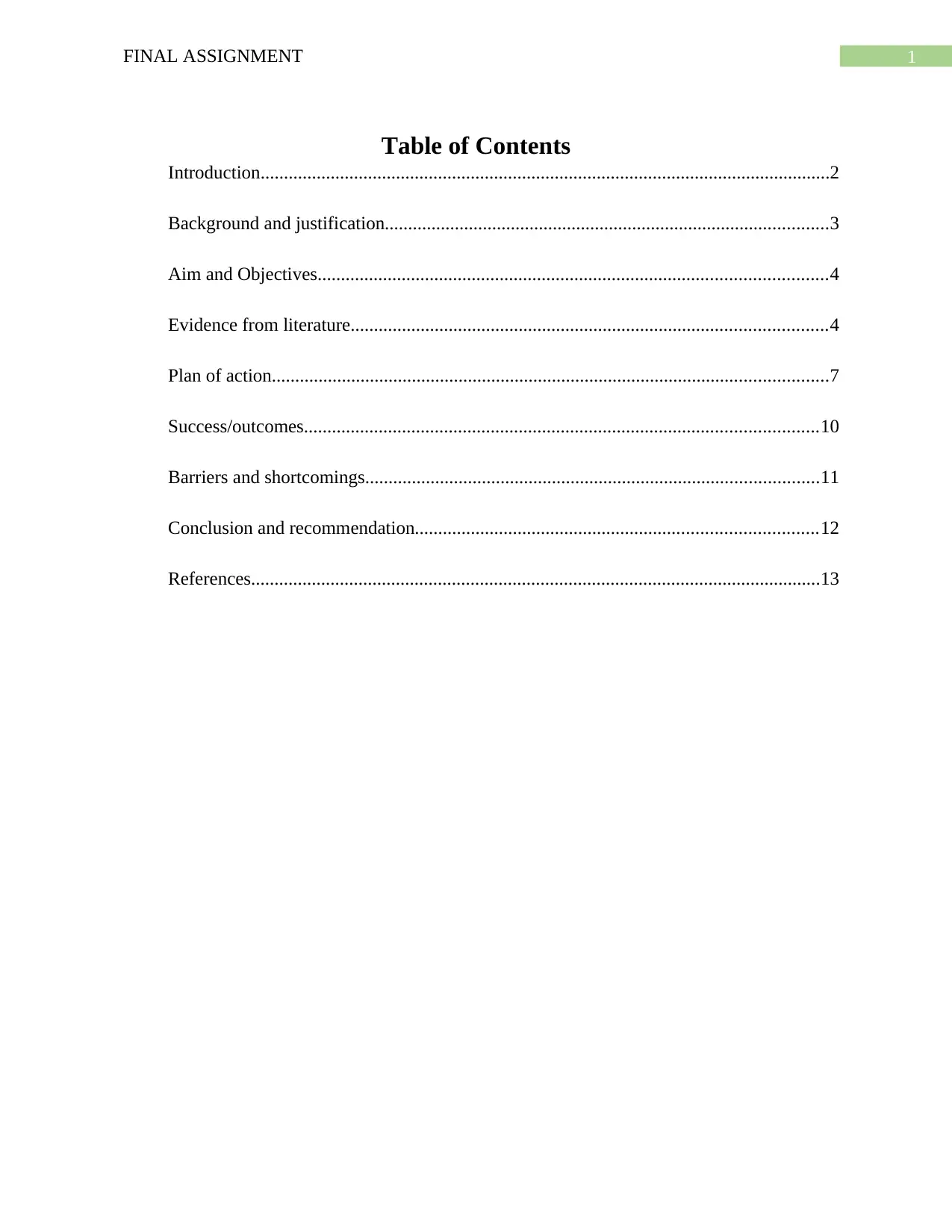
1FINAL ASSIGNMENT
Table of Contents
Introduction..........................................................................................................................2
Background and justification...............................................................................................3
Aim and Objectives.............................................................................................................4
Evidence from literature......................................................................................................4
Plan of action.......................................................................................................................7
Success/outcomes..............................................................................................................10
Barriers and shortcomings.................................................................................................11
Conclusion and recommendation......................................................................................12
References..........................................................................................................................13
Table of Contents
Introduction..........................................................................................................................2
Background and justification...............................................................................................3
Aim and Objectives.............................................................................................................4
Evidence from literature......................................................................................................4
Plan of action.......................................................................................................................7
Success/outcomes..............................................................................................................10
Barriers and shortcomings.................................................................................................11
Conclusion and recommendation......................................................................................12
References..........................................................................................................................13
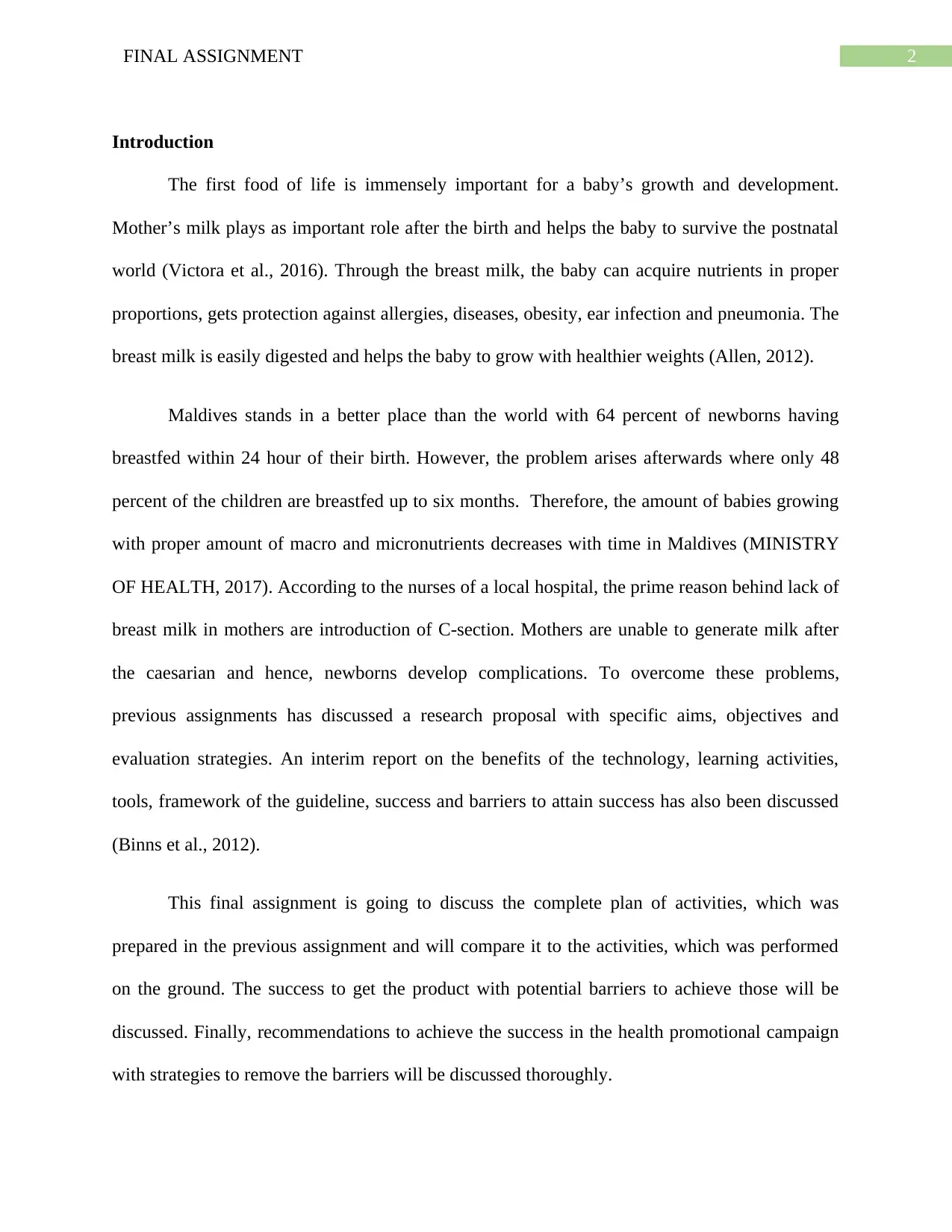
2FINAL ASSIGNMENT
Introduction
The first food of life is immensely important for a baby’s growth and development.
Mother’s milk plays as important role after the birth and helps the baby to survive the postnatal
world (Victora et al., 2016). Through the breast milk, the baby can acquire nutrients in proper
proportions, gets protection against allergies, diseases, obesity, ear infection and pneumonia. The
breast milk is easily digested and helps the baby to grow with healthier weights (Allen, 2012).
Maldives stands in a better place than the world with 64 percent of newborns having
breastfed within 24 hour of their birth. However, the problem arises afterwards where only 48
percent of the children are breastfed up to six months. Therefore, the amount of babies growing
with proper amount of macro and micronutrients decreases with time in Maldives (MINISTRY
OF HEALTH, 2017). According to the nurses of a local hospital, the prime reason behind lack of
breast milk in mothers are introduction of C-section. Mothers are unable to generate milk after
the caesarian and hence, newborns develop complications. To overcome these problems,
previous assignments has discussed a research proposal with specific aims, objectives and
evaluation strategies. An interim report on the benefits of the technology, learning activities,
tools, framework of the guideline, success and barriers to attain success has also been discussed
(Binns et al., 2012).
This final assignment is going to discuss the complete plan of activities, which was
prepared in the previous assignment and will compare it to the activities, which was performed
on the ground. The success to get the product with potential barriers to achieve those will be
discussed. Finally, recommendations to achieve the success in the health promotional campaign
with strategies to remove the barriers will be discussed thoroughly.
Introduction
The first food of life is immensely important for a baby’s growth and development.
Mother’s milk plays as important role after the birth and helps the baby to survive the postnatal
world (Victora et al., 2016). Through the breast milk, the baby can acquire nutrients in proper
proportions, gets protection against allergies, diseases, obesity, ear infection and pneumonia. The
breast milk is easily digested and helps the baby to grow with healthier weights (Allen, 2012).
Maldives stands in a better place than the world with 64 percent of newborns having
breastfed within 24 hour of their birth. However, the problem arises afterwards where only 48
percent of the children are breastfed up to six months. Therefore, the amount of babies growing
with proper amount of macro and micronutrients decreases with time in Maldives (MINISTRY
OF HEALTH, 2017). According to the nurses of a local hospital, the prime reason behind lack of
breast milk in mothers are introduction of C-section. Mothers are unable to generate milk after
the caesarian and hence, newborns develop complications. To overcome these problems,
previous assignments has discussed a research proposal with specific aims, objectives and
evaluation strategies. An interim report on the benefits of the technology, learning activities,
tools, framework of the guideline, success and barriers to attain success has also been discussed
(Binns et al., 2012).
This final assignment is going to discuss the complete plan of activities, which was
prepared in the previous assignment and will compare it to the activities, which was performed
on the ground. The success to get the product with potential barriers to achieve those will be
discussed. Finally, recommendations to achieve the success in the health promotional campaign
with strategies to remove the barriers will be discussed thoroughly.
⊘ This is a preview!⊘
Do you want full access?
Subscribe today to unlock all pages.

Trusted by 1+ million students worldwide
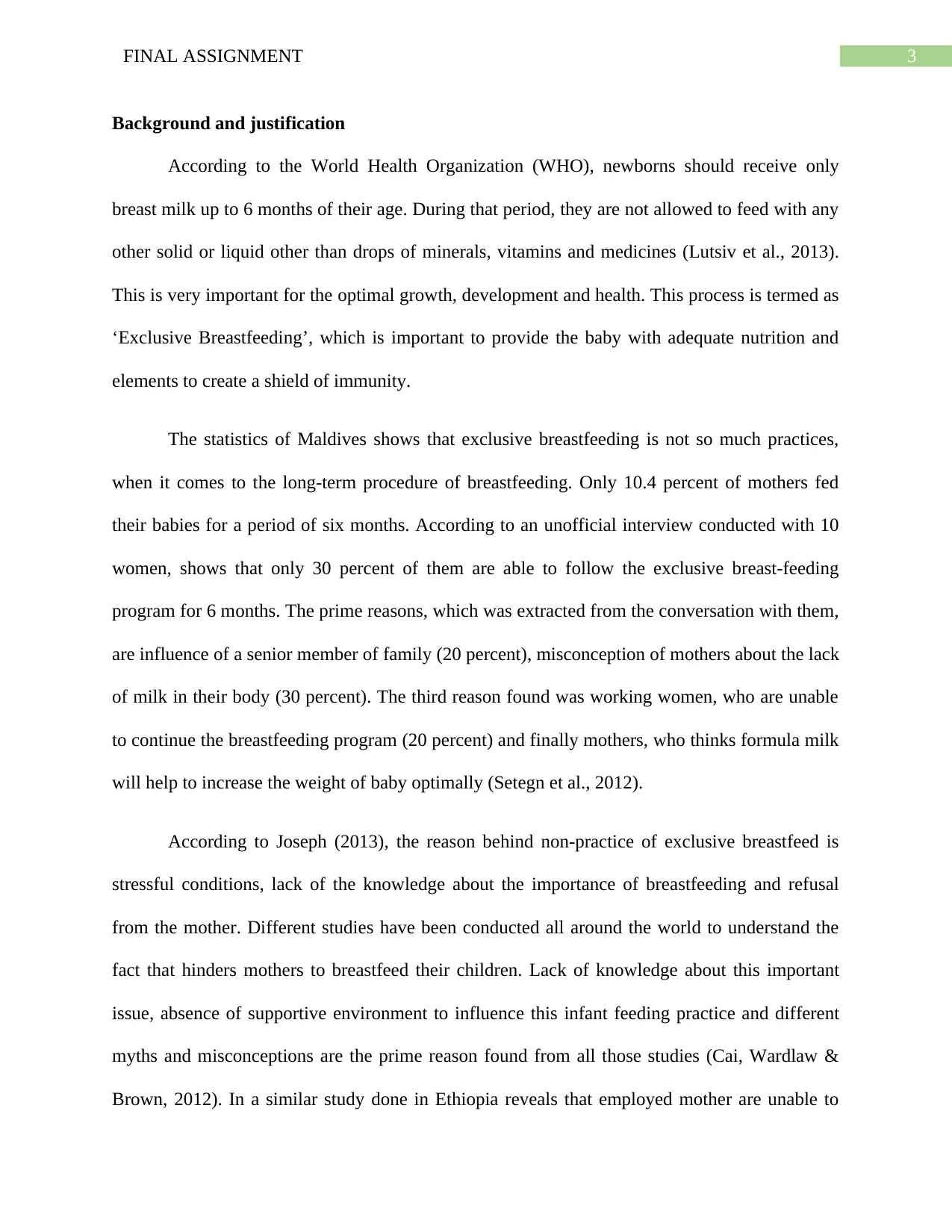
3FINAL ASSIGNMENT
Background and justification
According to the World Health Organization (WHO), newborns should receive only
breast milk up to 6 months of their age. During that period, they are not allowed to feed with any
other solid or liquid other than drops of minerals, vitamins and medicines (Lutsiv et al., 2013).
This is very important for the optimal growth, development and health. This process is termed as
‘Exclusive Breastfeeding’, which is important to provide the baby with adequate nutrition and
elements to create a shield of immunity.
The statistics of Maldives shows that exclusive breastfeeding is not so much practices,
when it comes to the long-term procedure of breastfeeding. Only 10.4 percent of mothers fed
their babies for a period of six months. According to an unofficial interview conducted with 10
women, shows that only 30 percent of them are able to follow the exclusive breast-feeding
program for 6 months. The prime reasons, which was extracted from the conversation with them,
are influence of a senior member of family (20 percent), misconception of mothers about the lack
of milk in their body (30 percent). The third reason found was working women, who are unable
to continue the breastfeeding program (20 percent) and finally mothers, who thinks formula milk
will help to increase the weight of baby optimally (Setegn et al., 2012).
According to Joseph (2013), the reason behind non-practice of exclusive breastfeed is
stressful conditions, lack of the knowledge about the importance of breastfeeding and refusal
from the mother. Different studies have been conducted all around the world to understand the
fact that hinders mothers to breastfeed their children. Lack of knowledge about this important
issue, absence of supportive environment to influence this infant feeding practice and different
myths and misconceptions are the prime reason found from all those studies (Cai, Wardlaw &
Brown, 2012). In a similar study done in Ethiopia reveals that employed mother are unable to
Background and justification
According to the World Health Organization (WHO), newborns should receive only
breast milk up to 6 months of their age. During that period, they are not allowed to feed with any
other solid or liquid other than drops of minerals, vitamins and medicines (Lutsiv et al., 2013).
This is very important for the optimal growth, development and health. This process is termed as
‘Exclusive Breastfeeding’, which is important to provide the baby with adequate nutrition and
elements to create a shield of immunity.
The statistics of Maldives shows that exclusive breastfeeding is not so much practices,
when it comes to the long-term procedure of breastfeeding. Only 10.4 percent of mothers fed
their babies for a period of six months. According to an unofficial interview conducted with 10
women, shows that only 30 percent of them are able to follow the exclusive breast-feeding
program for 6 months. The prime reasons, which was extracted from the conversation with them,
are influence of a senior member of family (20 percent), misconception of mothers about the lack
of milk in their body (30 percent). The third reason found was working women, who are unable
to continue the breastfeeding program (20 percent) and finally mothers, who thinks formula milk
will help to increase the weight of baby optimally (Setegn et al., 2012).
According to Joseph (2013), the reason behind non-practice of exclusive breastfeed is
stressful conditions, lack of the knowledge about the importance of breastfeeding and refusal
from the mother. Different studies have been conducted all around the world to understand the
fact that hinders mothers to breastfeed their children. Lack of knowledge about this important
issue, absence of supportive environment to influence this infant feeding practice and different
myths and misconceptions are the prime reason found from all those studies (Cai, Wardlaw &
Brown, 2012). In a similar study done in Ethiopia reveals that employed mother are unable to
Paraphrase This Document
Need a fresh take? Get an instant paraphrase of this document with our AI Paraphraser
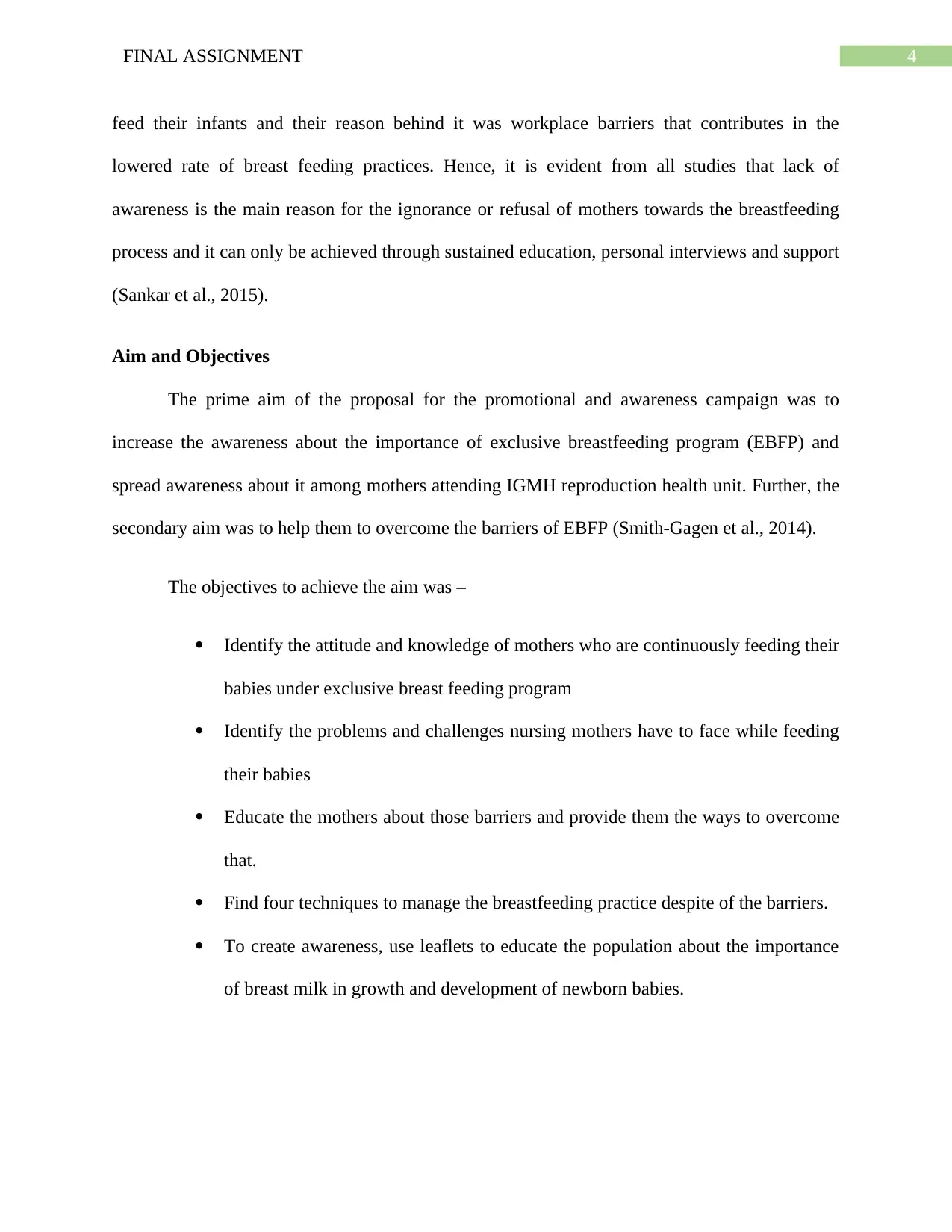
4FINAL ASSIGNMENT
feed their infants and their reason behind it was workplace barriers that contributes in the
lowered rate of breast feeding practices. Hence, it is evident from all studies that lack of
awareness is the main reason for the ignorance or refusal of mothers towards the breastfeeding
process and it can only be achieved through sustained education, personal interviews and support
(Sankar et al., 2015).
Aim and Objectives
The prime aim of the proposal for the promotional and awareness campaign was to
increase the awareness about the importance of exclusive breastfeeding program (EBFP) and
spread awareness about it among mothers attending IGMH reproduction health unit. Further, the
secondary aim was to help them to overcome the barriers of EBFP (Smith-Gagen et al., 2014).
The objectives to achieve the aim was –
Identify the attitude and knowledge of mothers who are continuously feeding their
babies under exclusive breast feeding program
Identify the problems and challenges nursing mothers have to face while feeding
their babies
Educate the mothers about those barriers and provide them the ways to overcome
that.
Find four techniques to manage the breastfeeding practice despite of the barriers.
To create awareness, use leaflets to educate the population about the importance
of breast milk in growth and development of newborn babies.
feed their infants and their reason behind it was workplace barriers that contributes in the
lowered rate of breast feeding practices. Hence, it is evident from all studies that lack of
awareness is the main reason for the ignorance or refusal of mothers towards the breastfeeding
process and it can only be achieved through sustained education, personal interviews and support
(Sankar et al., 2015).
Aim and Objectives
The prime aim of the proposal for the promotional and awareness campaign was to
increase the awareness about the importance of exclusive breastfeeding program (EBFP) and
spread awareness about it among mothers attending IGMH reproduction health unit. Further, the
secondary aim was to help them to overcome the barriers of EBFP (Smith-Gagen et al., 2014).
The objectives to achieve the aim was –
Identify the attitude and knowledge of mothers who are continuously feeding their
babies under exclusive breast feeding program
Identify the problems and challenges nursing mothers have to face while feeding
their babies
Educate the mothers about those barriers and provide them the ways to overcome
that.
Find four techniques to manage the breastfeeding practice despite of the barriers.
To create awareness, use leaflets to educate the population about the importance
of breast milk in growth and development of newborn babies.
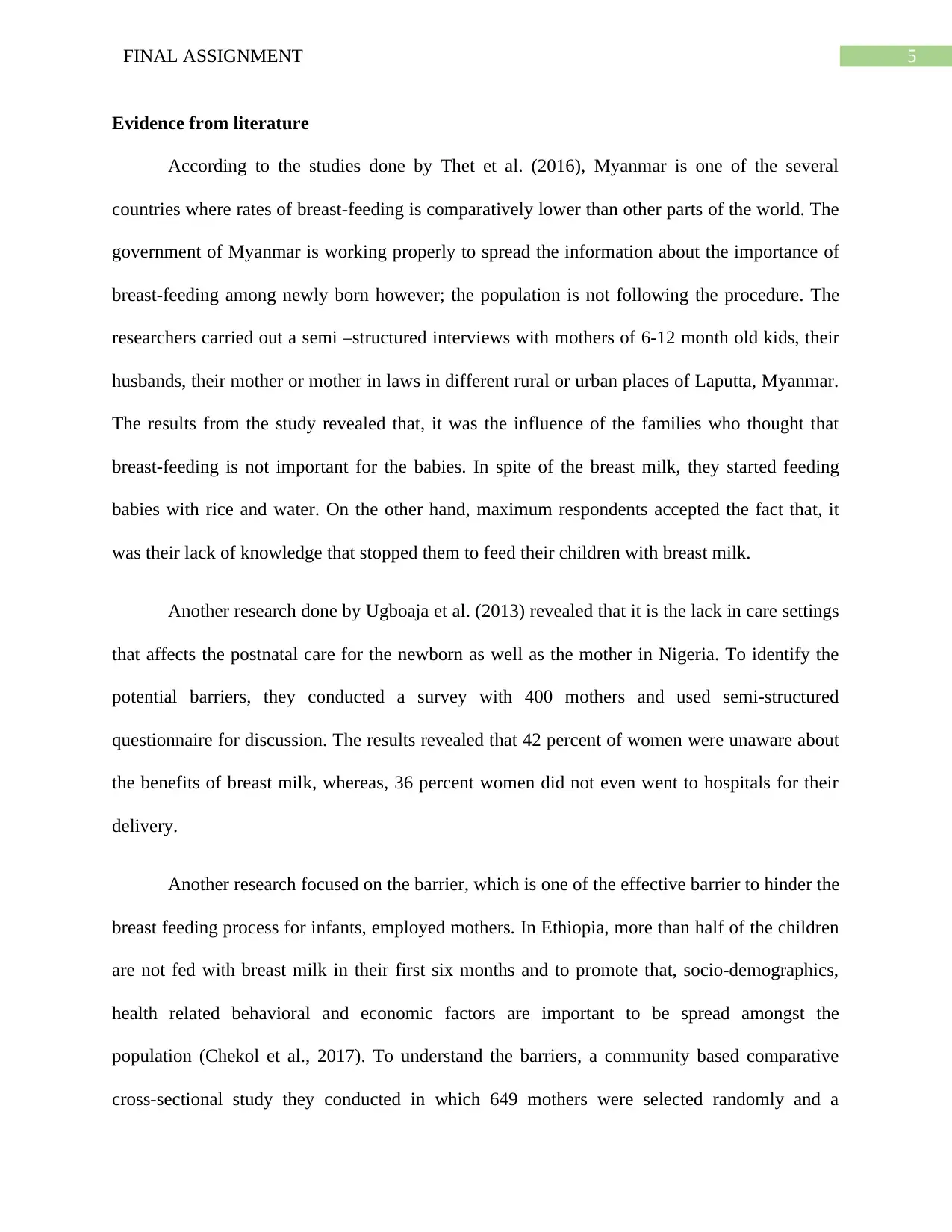
5FINAL ASSIGNMENT
Evidence from literature
According to the studies done by Thet et al. (2016), Myanmar is one of the several
countries where rates of breast-feeding is comparatively lower than other parts of the world. The
government of Myanmar is working properly to spread the information about the importance of
breast-feeding among newly born however; the population is not following the procedure. The
researchers carried out a semi –structured interviews with mothers of 6-12 month old kids, their
husbands, their mother or mother in laws in different rural or urban places of Laputta, Myanmar.
The results from the study revealed that, it was the influence of the families who thought that
breast-feeding is not important for the babies. In spite of the breast milk, they started feeding
babies with rice and water. On the other hand, maximum respondents accepted the fact that, it
was their lack of knowledge that stopped them to feed their children with breast milk.
Another research done by Ugboaja et al. (2013) revealed that it is the lack in care settings
that affects the postnatal care for the newborn as well as the mother in Nigeria. To identify the
potential barriers, they conducted a survey with 400 mothers and used semi-structured
questionnaire for discussion. The results revealed that 42 percent of women were unaware about
the benefits of breast milk, whereas, 36 percent women did not even went to hospitals for their
delivery.
Another research focused on the barrier, which is one of the effective barrier to hinder the
breast feeding process for infants, employed mothers. In Ethiopia, more than half of the children
are not fed with breast milk in their first six months and to promote that, socio-demographics,
health related behavioral and economic factors are important to be spread amongst the
population (Chekol et al., 2017). To understand the barriers, a community based comparative
cross-sectional study they conducted in which 649 mothers were selected randomly and a
Evidence from literature
According to the studies done by Thet et al. (2016), Myanmar is one of the several
countries where rates of breast-feeding is comparatively lower than other parts of the world. The
government of Myanmar is working properly to spread the information about the importance of
breast-feeding among newly born however; the population is not following the procedure. The
researchers carried out a semi –structured interviews with mothers of 6-12 month old kids, their
husbands, their mother or mother in laws in different rural or urban places of Laputta, Myanmar.
The results from the study revealed that, it was the influence of the families who thought that
breast-feeding is not important for the babies. In spite of the breast milk, they started feeding
babies with rice and water. On the other hand, maximum respondents accepted the fact that, it
was their lack of knowledge that stopped them to feed their children with breast milk.
Another research done by Ugboaja et al. (2013) revealed that it is the lack in care settings
that affects the postnatal care for the newborn as well as the mother in Nigeria. To identify the
potential barriers, they conducted a survey with 400 mothers and used semi-structured
questionnaire for discussion. The results revealed that 42 percent of women were unaware about
the benefits of breast milk, whereas, 36 percent women did not even went to hospitals for their
delivery.
Another research focused on the barrier, which is one of the effective barrier to hinder the
breast feeding process for infants, employed mothers. In Ethiopia, more than half of the children
are not fed with breast milk in their first six months and to promote that, socio-demographics,
health related behavioral and economic factors are important to be spread amongst the
population (Chekol et al., 2017). To understand the barriers, a community based comparative
cross-sectional study they conducted in which 649 mothers were selected randomly and a
⊘ This is a preview!⊘
Do you want full access?
Subscribe today to unlock all pages.

Trusted by 1+ million students worldwide
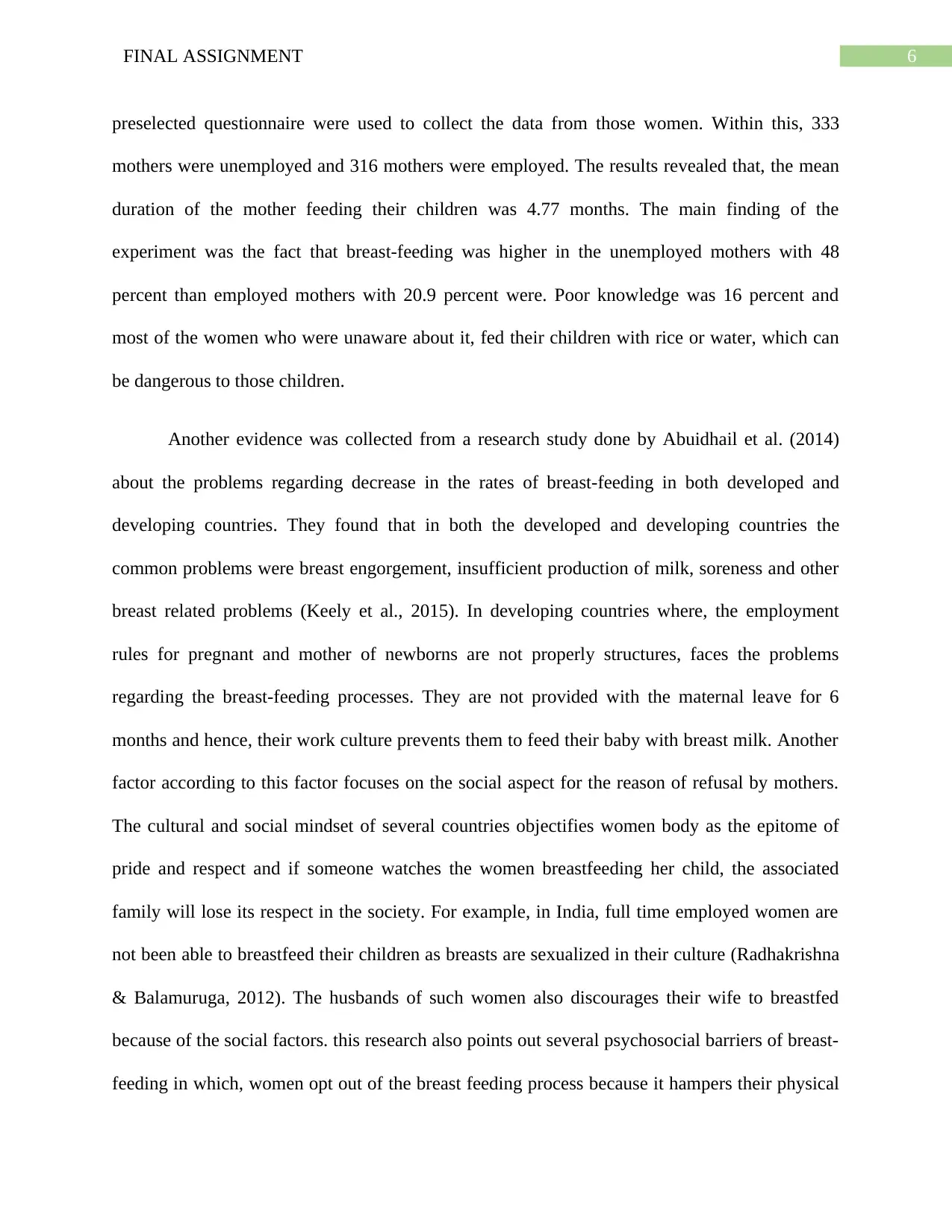
6FINAL ASSIGNMENT
preselected questionnaire were used to collect the data from those women. Within this, 333
mothers were unemployed and 316 mothers were employed. The results revealed that, the mean
duration of the mother feeding their children was 4.77 months. The main finding of the
experiment was the fact that breast-feeding was higher in the unemployed mothers with 48
percent than employed mothers with 20.9 percent were. Poor knowledge was 16 percent and
most of the women who were unaware about it, fed their children with rice or water, which can
be dangerous to those children.
Another evidence was collected from a research study done by Abuidhail et al. (2014)
about the problems regarding decrease in the rates of breast-feeding in both developed and
developing countries. They found that in both the developed and developing countries the
common problems were breast engorgement, insufficient production of milk, soreness and other
breast related problems (Keely et al., 2015). In developing countries where, the employment
rules for pregnant and mother of newborns are not properly structures, faces the problems
regarding the breast-feeding processes. They are not provided with the maternal leave for 6
months and hence, their work culture prevents them to feed their baby with breast milk. Another
factor according to this factor focuses on the social aspect for the reason of refusal by mothers.
The cultural and social mindset of several countries objectifies women body as the epitome of
pride and respect and if someone watches the women breastfeeding her child, the associated
family will lose its respect in the society. For example, in India, full time employed women are
not been able to breastfeed their children as breasts are sexualized in their culture (Radhakrishna
& Balamuruga, 2012). The husbands of such women also discourages their wife to breastfed
because of the social factors. this research also points out several psychosocial barriers of breast-
feeding in which, women opt out of the breast feeding process because it hampers their physical
preselected questionnaire were used to collect the data from those women. Within this, 333
mothers were unemployed and 316 mothers were employed. The results revealed that, the mean
duration of the mother feeding their children was 4.77 months. The main finding of the
experiment was the fact that breast-feeding was higher in the unemployed mothers with 48
percent than employed mothers with 20.9 percent were. Poor knowledge was 16 percent and
most of the women who were unaware about it, fed their children with rice or water, which can
be dangerous to those children.
Another evidence was collected from a research study done by Abuidhail et al. (2014)
about the problems regarding decrease in the rates of breast-feeding in both developed and
developing countries. They found that in both the developed and developing countries the
common problems were breast engorgement, insufficient production of milk, soreness and other
breast related problems (Keely et al., 2015). In developing countries where, the employment
rules for pregnant and mother of newborns are not properly structures, faces the problems
regarding the breast-feeding processes. They are not provided with the maternal leave for 6
months and hence, their work culture prevents them to feed their baby with breast milk. Another
factor according to this factor focuses on the social aspect for the reason of refusal by mothers.
The cultural and social mindset of several countries objectifies women body as the epitome of
pride and respect and if someone watches the women breastfeeding her child, the associated
family will lose its respect in the society. For example, in India, full time employed women are
not been able to breastfeed their children as breasts are sexualized in their culture (Radhakrishna
& Balamuruga, 2012). The husbands of such women also discourages their wife to breastfed
because of the social factors. this research also points out several psychosocial barriers of breast-
feeding in which, women opt out of the breast feeding process because it hampers their physical
Paraphrase This Document
Need a fresh take? Get an instant paraphrase of this document with our AI Paraphraser
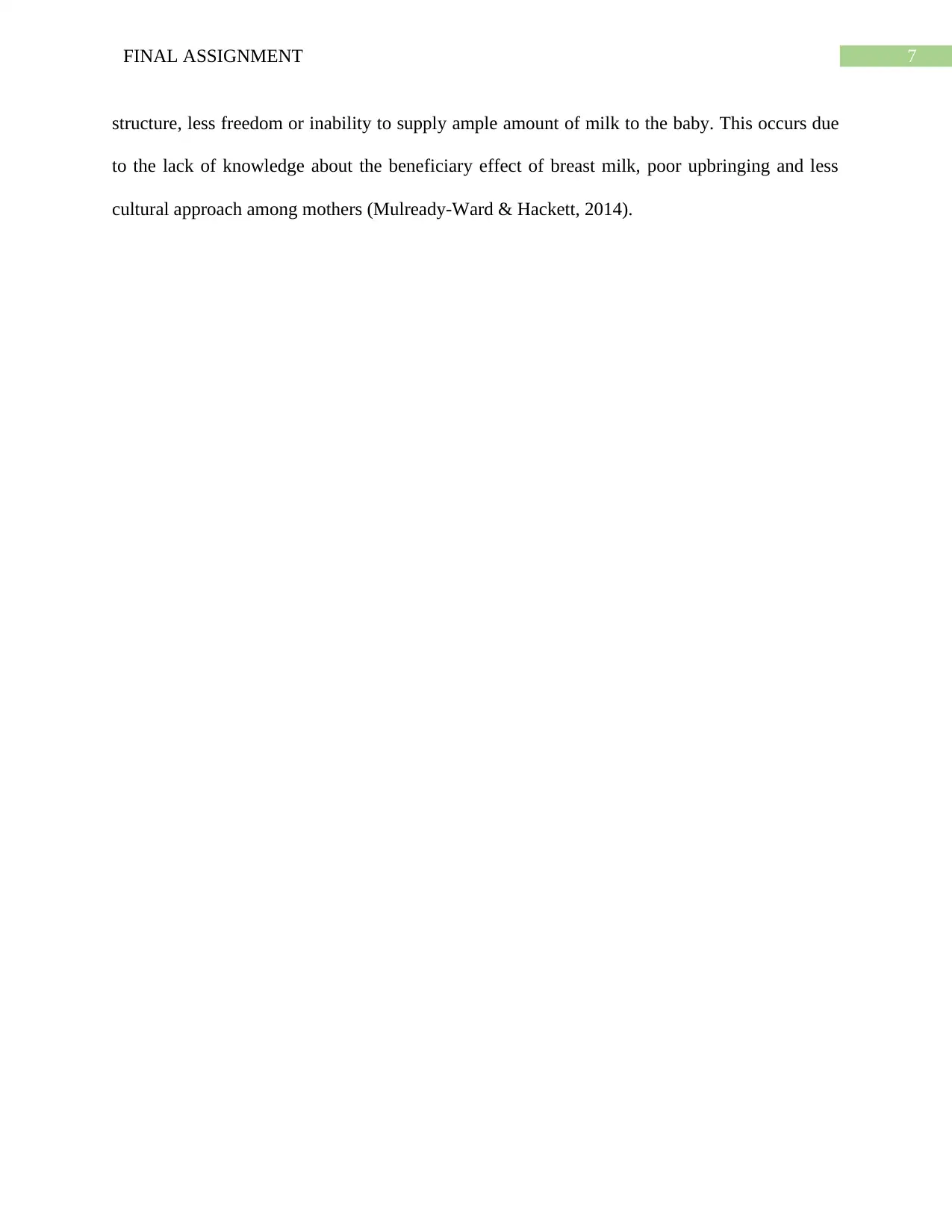
7FINAL ASSIGNMENT
structure, less freedom or inability to supply ample amount of milk to the baby. This occurs due
to the lack of knowledge about the beneficiary effect of breast milk, poor upbringing and less
cultural approach among mothers (Mulready-Ward & Hackett, 2014).
structure, less freedom or inability to supply ample amount of milk to the baby. This occurs due
to the lack of knowledge about the beneficiary effect of breast milk, poor upbringing and less
cultural approach among mothers (Mulready-Ward & Hackett, 2014).
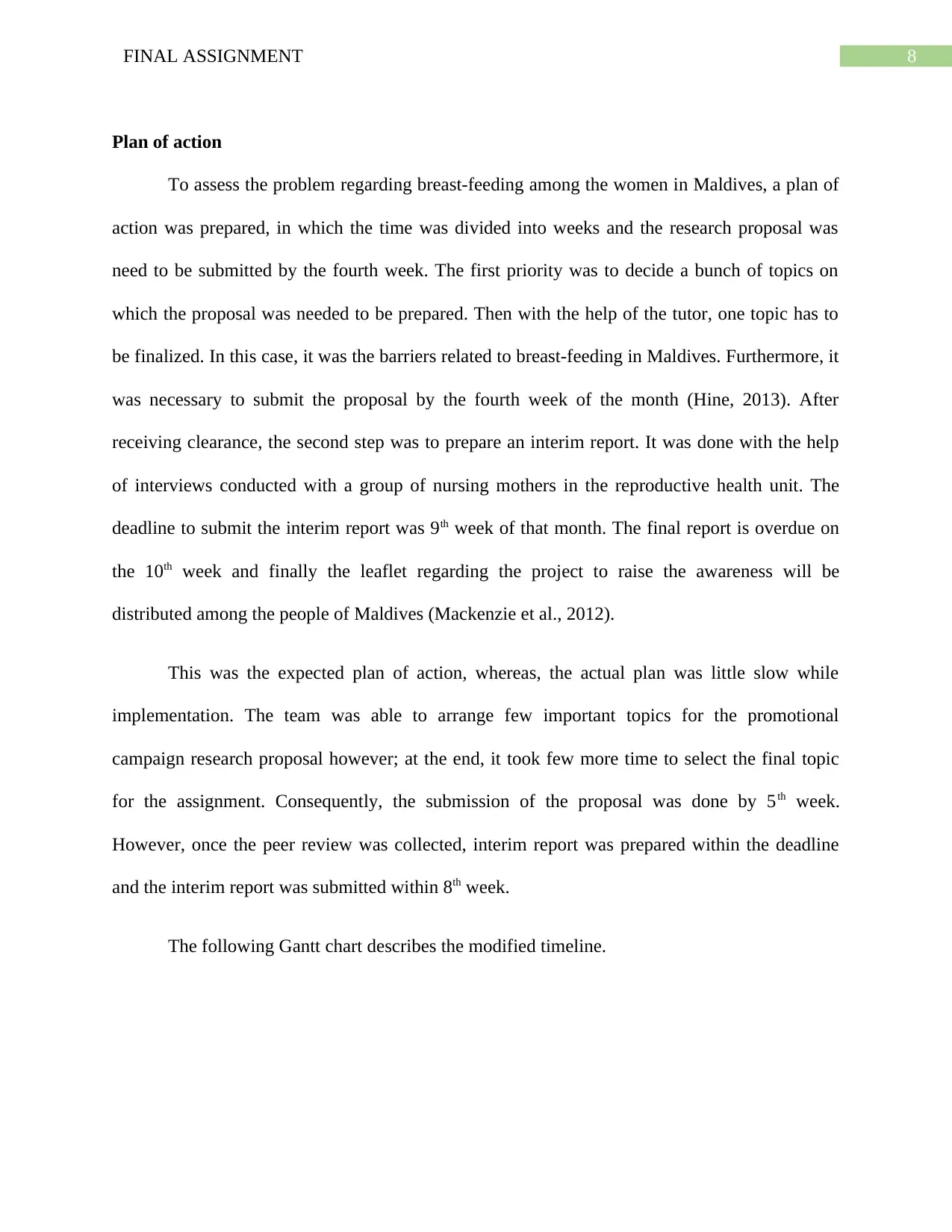
8FINAL ASSIGNMENT
Plan of action
To assess the problem regarding breast-feeding among the women in Maldives, a plan of
action was prepared, in which the time was divided into weeks and the research proposal was
need to be submitted by the fourth week. The first priority was to decide a bunch of topics on
which the proposal was needed to be prepared. Then with the help of the tutor, one topic has to
be finalized. In this case, it was the barriers related to breast-feeding in Maldives. Furthermore, it
was necessary to submit the proposal by the fourth week of the month (Hine, 2013). After
receiving clearance, the second step was to prepare an interim report. It was done with the help
of interviews conducted with a group of nursing mothers in the reproductive health unit. The
deadline to submit the interim report was 9th week of that month. The final report is overdue on
the 10th week and finally the leaflet regarding the project to raise the awareness will be
distributed among the people of Maldives (Mackenzie et al., 2012).
This was the expected plan of action, whereas, the actual plan was little slow while
implementation. The team was able to arrange few important topics for the promotional
campaign research proposal however; at the end, it took few more time to select the final topic
for the assignment. Consequently, the submission of the proposal was done by 5th week.
However, once the peer review was collected, interim report was prepared within the deadline
and the interim report was submitted within 8th week.
The following Gantt chart describes the modified timeline.
Plan of action
To assess the problem regarding breast-feeding among the women in Maldives, a plan of
action was prepared, in which the time was divided into weeks and the research proposal was
need to be submitted by the fourth week. The first priority was to decide a bunch of topics on
which the proposal was needed to be prepared. Then with the help of the tutor, one topic has to
be finalized. In this case, it was the barriers related to breast-feeding in Maldives. Furthermore, it
was necessary to submit the proposal by the fourth week of the month (Hine, 2013). After
receiving clearance, the second step was to prepare an interim report. It was done with the help
of interviews conducted with a group of nursing mothers in the reproductive health unit. The
deadline to submit the interim report was 9th week of that month. The final report is overdue on
the 10th week and finally the leaflet regarding the project to raise the awareness will be
distributed among the people of Maldives (Mackenzie et al., 2012).
This was the expected plan of action, whereas, the actual plan was little slow while
implementation. The team was able to arrange few important topics for the promotional
campaign research proposal however; at the end, it took few more time to select the final topic
for the assignment. Consequently, the submission of the proposal was done by 5th week.
However, once the peer review was collected, interim report was prepared within the deadline
and the interim report was submitted within 8th week.
The following Gantt chart describes the modified timeline.
⊘ This is a preview!⊘
Do you want full access?
Subscribe today to unlock all pages.

Trusted by 1+ million students worldwide
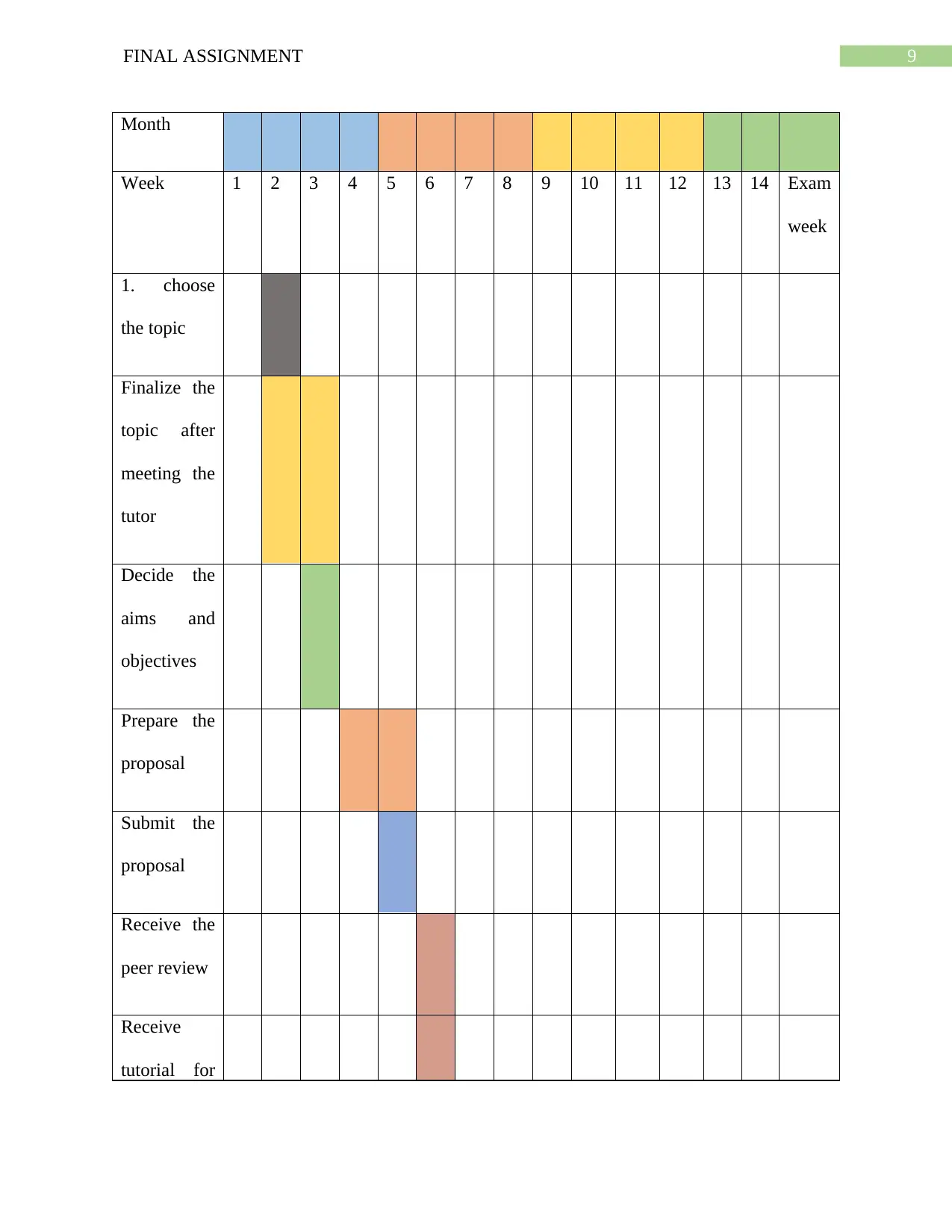
9FINAL ASSIGNMENT
Month
Week 1 2 3 4 5 6 7 8 9 10 11 12 13 14 Exam
week
1. choose
the topic
Finalize the
topic after
meeting the
tutor
Decide the
aims and
objectives
Prepare the
proposal
Submit the
proposal
Receive the
peer review
Receive
tutorial for
Month
Week 1 2 3 4 5 6 7 8 9 10 11 12 13 14 Exam
week
1. choose
the topic
Finalize the
topic after
meeting the
tutor
Decide the
aims and
objectives
Prepare the
proposal
Submit the
proposal
Receive the
peer review
Receive
tutorial for
Paraphrase This Document
Need a fresh take? Get an instant paraphrase of this document with our AI Paraphraser
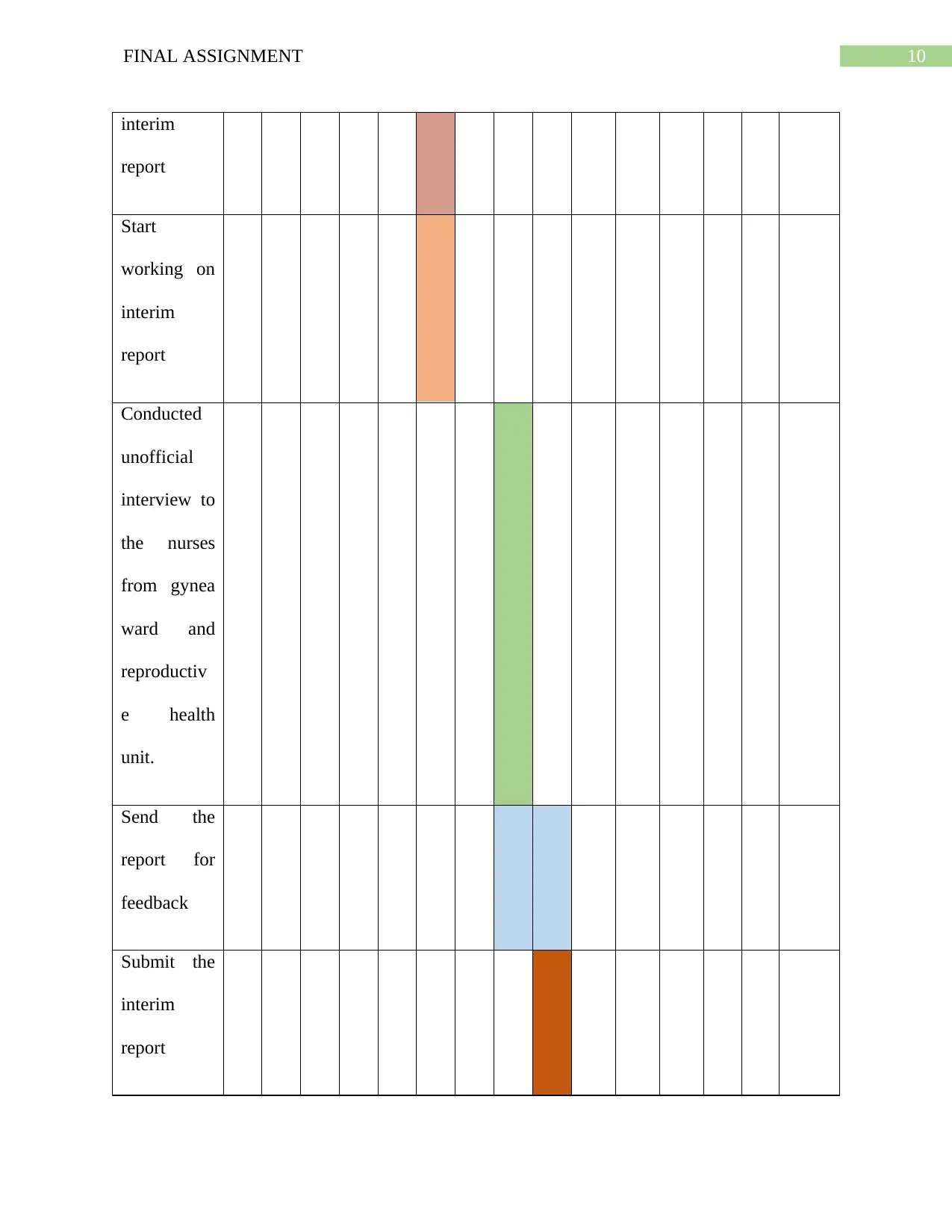
10FINAL ASSIGNMENT
interim
report
Start
working on
interim
report
Conducted
unofficial
interview to
the nurses
from gynea
ward and
reproductiv
e health
unit.
Send the
report for
feedback
Submit the
interim
report
interim
report
Start
working on
interim
report
Conducted
unofficial
interview to
the nurses
from gynea
ward and
reproductiv
e health
unit.
Send the
report for
feedback
Submit the
interim
report
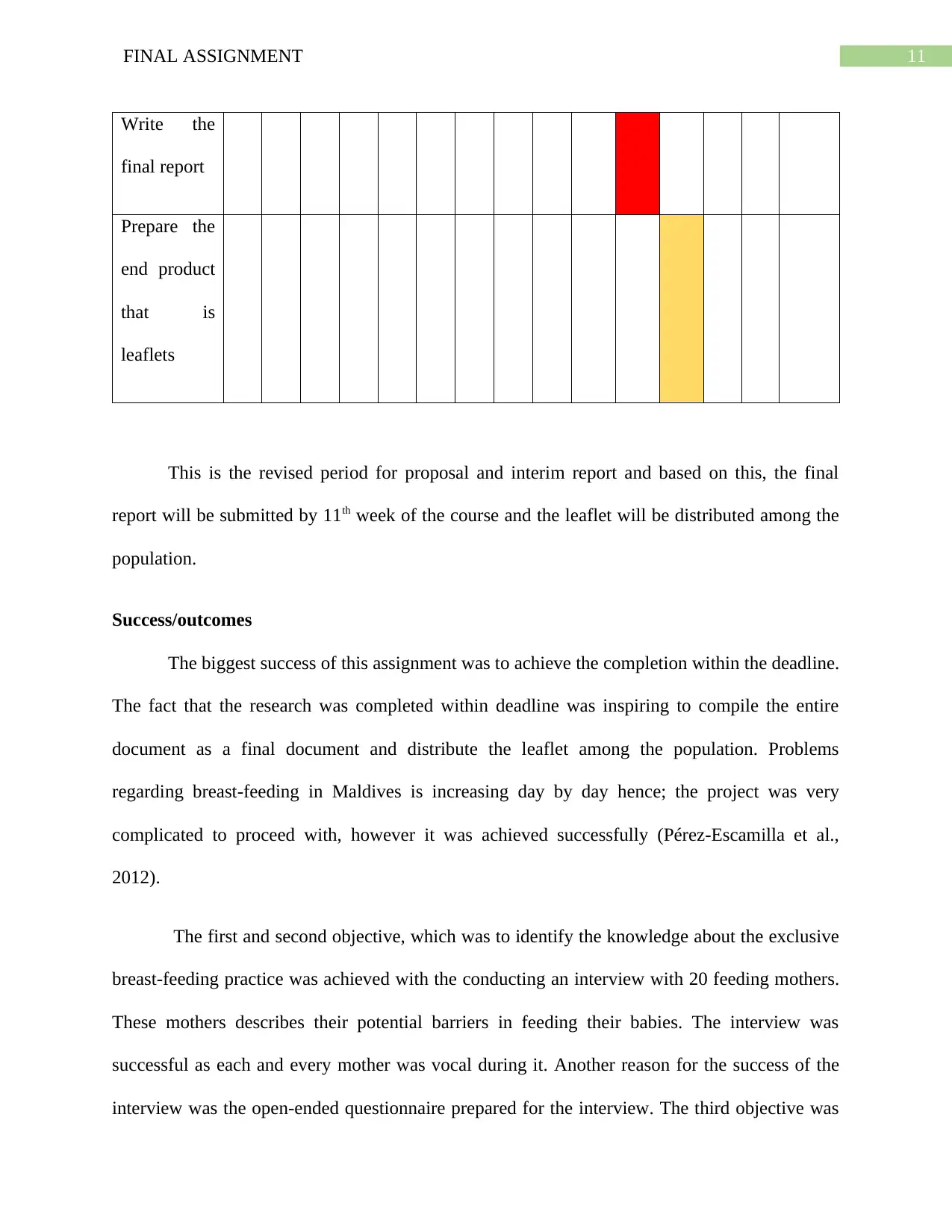
11FINAL ASSIGNMENT
Write the
final report
Prepare the
end product
that is
leaflets
This is the revised period for proposal and interim report and based on this, the final
report will be submitted by 11th week of the course and the leaflet will be distributed among the
population.
Success/outcomes
The biggest success of this assignment was to achieve the completion within the deadline.
The fact that the research was completed within deadline was inspiring to compile the entire
document as a final document and distribute the leaflet among the population. Problems
regarding breast-feeding in Maldives is increasing day by day hence; the project was very
complicated to proceed with, however it was achieved successfully (Pérez-Escamilla et al.,
2012).
The first and second objective, which was to identify the knowledge about the exclusive
breast-feeding practice was achieved with the conducting an interview with 20 feeding mothers.
These mothers describes their potential barriers in feeding their babies. The interview was
successful as each and every mother was vocal during it. Another reason for the success of the
interview was the open-ended questionnaire prepared for the interview. The third objective was
Write the
final report
Prepare the
end product
that is
leaflets
This is the revised period for proposal and interim report and based on this, the final
report will be submitted by 11th week of the course and the leaflet will be distributed among the
population.
Success/outcomes
The biggest success of this assignment was to achieve the completion within the deadline.
The fact that the research was completed within deadline was inspiring to compile the entire
document as a final document and distribute the leaflet among the population. Problems
regarding breast-feeding in Maldives is increasing day by day hence; the project was very
complicated to proceed with, however it was achieved successfully (Pérez-Escamilla et al.,
2012).
The first and second objective, which was to identify the knowledge about the exclusive
breast-feeding practice was achieved with the conducting an interview with 20 feeding mothers.
These mothers describes their potential barriers in feeding their babies. The interview was
successful as each and every mother was vocal during it. Another reason for the success of the
interview was the open-ended questionnaire prepared for the interview. The third objective was
⊘ This is a preview!⊘
Do you want full access?
Subscribe today to unlock all pages.

Trusted by 1+ million students worldwide
1 out of 17
Related Documents
Your All-in-One AI-Powered Toolkit for Academic Success.
+13062052269
info@desklib.com
Available 24*7 on WhatsApp / Email
![[object Object]](/_next/static/media/star-bottom.7253800d.svg)
Unlock your academic potential
Copyright © 2020–2025 A2Z Services. All Rights Reserved. Developed and managed by ZUCOL.





